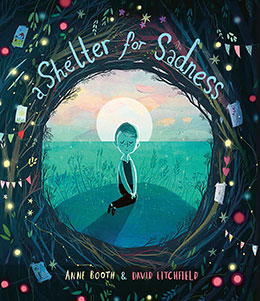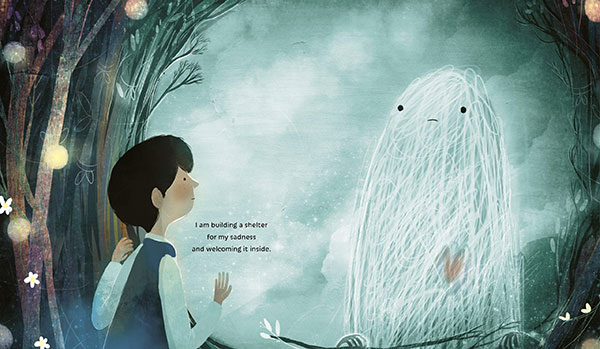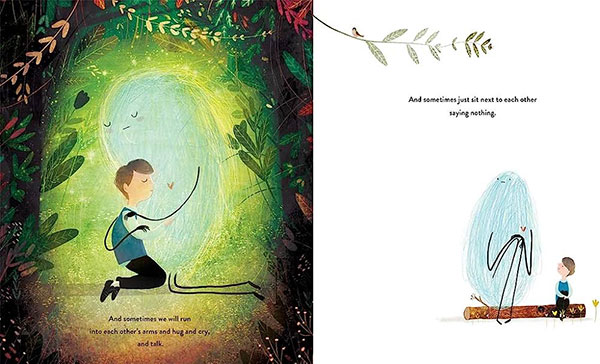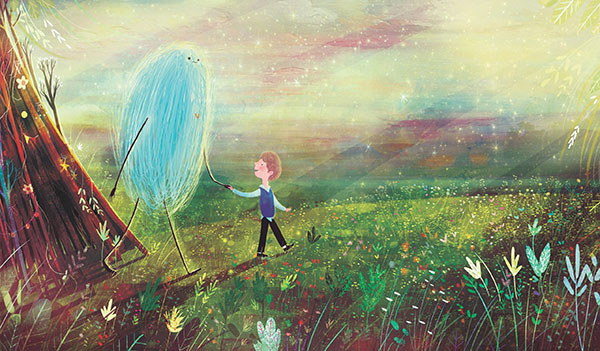 Sometimes, I am so touched by a book that I cannot figure out how best to share it with kids. Such is the case with A Shelter for Sadness by Anne Booth and David Litchfield. I was given this book by a friend of mine who was dying of cancer. It struck us both as so wise … such a gift … deeply meaningful. And I knew I wanted to share it with children in my life, but I wasn’t sure how. So, I conducted an experiment.
Sometimes, I am so touched by a book that I cannot figure out how best to share it with kids. Such is the case with A Shelter for Sadness by Anne Booth and David Litchfield. I was given this book by a friend of mine who was dying of cancer. It struck us both as so wise … such a gift … deeply meaningful. And I knew I wanted to share it with children in my life, but I wasn’t sure how. So, I conducted an experiment.
In this beautiful book, Sadness — the emotional state — is given a shape, a form. It has a simple face with two dot eyes and a line for a mouth that can turn up or down, open or close. There’s a glimmer of a heart, but the rest of its body is made of what can only be described as scribbles. Which seems like an excellent way to represent sadness to me.
The boy who narrates the book builds a shelter for his Sadness.
Sadness has come to live with me, and I am building it a shelter.
I am building a shelter for my sadness and welcoming it inside.

written by Anne Booth, published by Peachtree, 2021
In the shelter the boy gives Sadness a space to sit or lie down. Sadness is welcome to curl up small or spread out big. Sadness can be very noisy or very quiet. Or anything in between.
The book proceeds with this gentleness and grace toward Sadness — the shelter allow Sadness to be what it will be. The shelter has windows — with curtains to draw if Sadness wants. There’s light from candles or lamps if wanted. The shelter protects and provides space for Sadness. The boy plants a garden outside the shelter and the Sadness can come out and explore … if it wants.
The illustrations are beautiful. The words are gorgeous. Sadness lives in the shelter through nature’s seasons and the boy visits with tea or for a hug or a talk. Sometimes they just sit next to each other and say nothing.

written by Anne Booth, published by Peachtree, 2021
So, my experiment …. I read the book to the kids without showing them the pictures, asking them to draw their own version of Sadness and a shelter for it. I read the book slowly. They drew. It was fascinating. Their Sadnesses had more form, no changes in facial expressions, and were made of hard lines and angles. (Except for the girl who drew a version of Sadness from Pixar’s Inside Out.) Their shelters lacked whimsy. One was a fence with maybe barbed wire on top.
When I read them the book with the pictures they seemed almost relieved. They noticed Sadness’ heart right away. They noticed that the tangle of lines that made of Sadness at the beginning of the book looked like they’d been combed at the end. They added whimsical decorations to their shelters. One boy said he’d like to live in the shelter the boy made.

written by Anne Booth, published by Peachtree, 2021
We drew and talked a little about what it feels like to be sad, and what it feels like when people try to force you to be happy when you’re sad. We talked about when sadness is something to shelter and care for and when sadness is something we need to ask others for help in dealing with it.
But mostly they decorated their shelters with hearts and stars and twinkly lights. They put clothes on their Sadness characters.
I love this book so much — the gentle idea of offering shelter for our Sadness. The importance of planting a garden outside the shelter. The importance of visiting our Sadness, but not moving in with it. I’m grateful for the bibliotherapy this book can provide for kids. Children know Sadness. Some know depression. I like having this book on my shelves to share. I like having this book on my shelves to read to myself and my Sadness who visits at times.

What a beautiful, wise book. I’m sorry I have never heard of it before, and I’m surprised it hasn’t gotten more recognition. I love the experiment you conducted with children. Thank you for letting me know about this title. It sounds like a book everyone could use.
Yes, I think so, David. It’s so lovely.
This sounds like such a wonderful book – I’m off to put it on my reading list. Thanks, Melanie. And it’s amazing what the illustrations can do, isn’t it? I love that the art here gentled the story in kids’ minds…